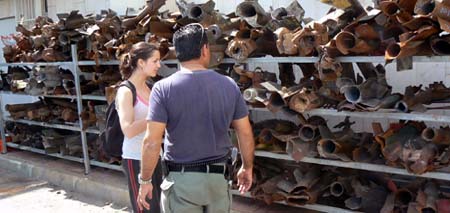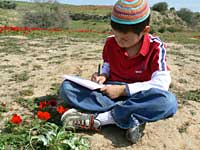This website was created in 2008 and taken offline in 2018.
|
|||
My purpose in going to the Sderot, Israel, area was to experience for a short time what residents there have been living with for eight years. Rocket fire from Gaza has been going on for that long, a condition that would seem to cause almost everyone to leave. But the facts are different: over eighty percent of the people living here have stayed, and Sapir Academic College has actually grown. What was I expecting to find? Nearly all of the reports I had read, or watched on sites like youtube, showed a population in panic, people running, children screaming, a city under constant siege. I wondered if this could be the total picture. It was not. What I have found is a great ability by individuals to adapt to the living conditions in the Sderot area, where any minute a kassam rocket could fall out of the sky and kill you. During periods of time when rockets were falling every few minutes, I would watch the immediate panic as most people scrambled for shelter, then I would watch in amazement when these same people assumed their normal life within a few seconds. But this perception is also not the total picture. There is intense anguish and stress among many people, and many reactions similar to post-traumatic stress syndrome. But as many have said, this is not "post," or after the fact. This is ongoing. The psychological wounds will be many, and some will not be known for years. What can be predicted of a child who grows into young adulthood knowing only rocket fire from a hostile neighbor? One month is not enough time to gain much insight into why and how people continue to live under this constant threat from neighboring Gaza. But it is enough time to walk through the wheat fields in the border kibbutzim and see how much labor has gone into developing the land. It is enough time to visit these communities and watch people enjoy a pleasant afternoon in the early March sunshine, with children and grandchildren playing outside. It is enough time to be invited in for tea and to hear of the history of how this land was developed. And out of these interactions some insight can be gained. It is a beautiful landscape, a desert brought to life with a combination of hard work, knowledge, and a fortunate access to water. Living can be comfortable here if the effort is made. It is easy to understand why someone would not want to leave, would not want to give up a home where a family has lived for many generations. Some of the farming communities are older than the country of Israel. They will not easily be moved. In the urban area of Sderot the direct connection with the land is not as strong. But there is a growing population in Sderot that has a religious connection to the land, and this involvement is a far older claim. "Now Abraham moved on from there into the region of the Negev and lived between Kadesh and Shur." (Genesis 20) These roots go much deeper than the roots of trees planted in the 1940s. The intent of this website has not been to explore the conflicting historical claims to this land. These discussions go on in various states of equanimity or rage in many locations. My intent was to experience, and I have done that. And out of this experience has come a deep respect for those who continue to live on the Gaza border, who live with determination to go on with their lives, and who live with the courage to face the dangers each night or day might bring. The Gaza area has been a battlefield for most of the ancient and recent empires of the Middle East, including the Pharaohs of Egypt, the Assyrians, the Persians, the Greeks, the Romans, the Crusaders, and into modern times. When I spoke with Rachel Bar-On, who at the age of 19, in 1943, came to the Negev to build a community, I asked her about the relations with the Arab community. "There was a war," she said. "We won." The tragedy for everyone on both sides of the Israel/Gaza border is that his war still goes on. |
|||


